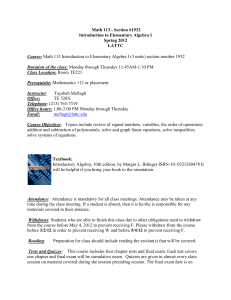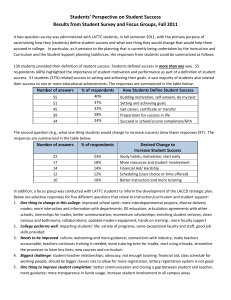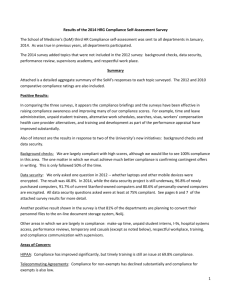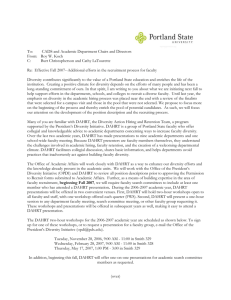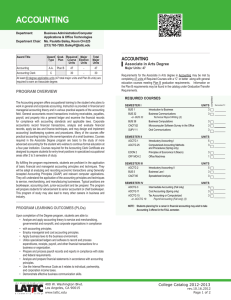Faculty Convocation Input – Staff Development (training, orientation
advertisement
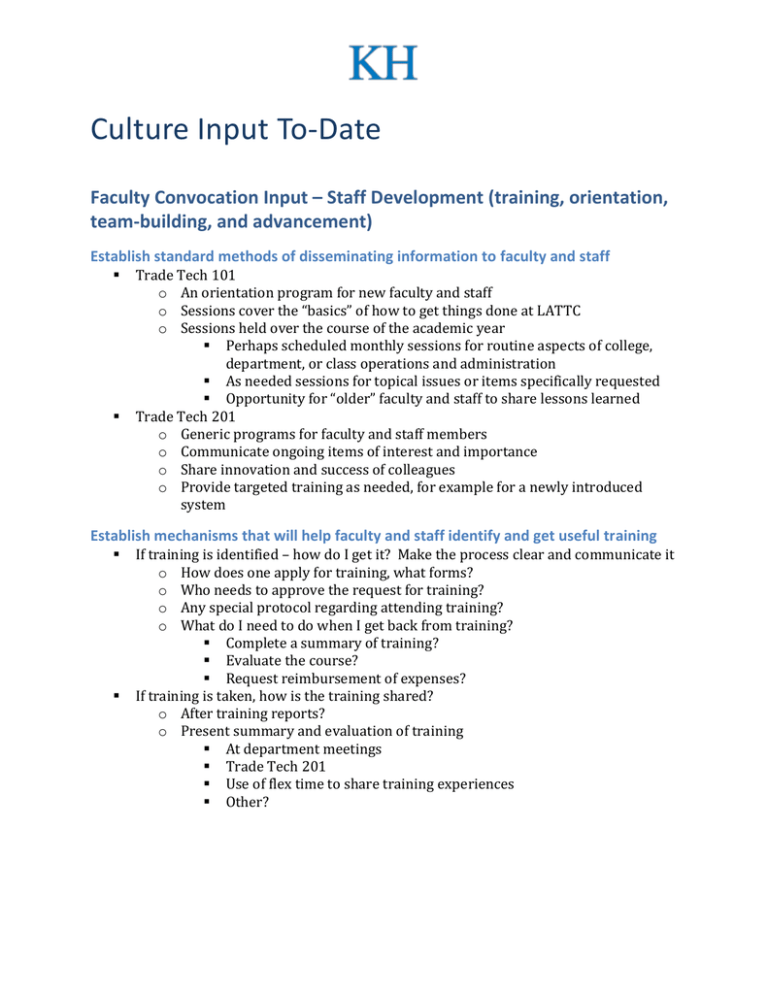
Culture Input To-Date Faculty Convocation Input – Staff Development (training, orientation, team-building, and advancement) Establish standard methods of disseminating information to faculty and staff Trade Tech 101 o An orientation program for new faculty and staff o Sessions cover the “basics” of how to get things done at LATTC o Sessions held over the course of the academic year Perhaps scheduled monthly sessions for routine aspects of college, department, or class operations and administration As needed sessions for topical issues or items specifically requested Opportunity for “older” faculty and staff to share lessons learned Trade Tech 201 o Generic programs for faculty and staff members o Communicate ongoing items of interest and importance o Share innovation and success of colleagues o Provide targeted training as needed, for example for a newly introduced system Establish mechanisms that will help faculty and staff identify and get useful training If training is identified – how do I get it? Make the process clear and communicate it o How does one apply for training, what forms? o Who needs to approve the request for training? o Any special protocol regarding attending training? o What do I need to do when I get back from training? Complete a summary of training? Evaluate the course? Request reimbursement of expenses? If training is taken, how is the training shared? o After training reports? o Present summary and evaluation of training At department meetings Trade Tech 201 Use of flex time to share training experiences Other? Establish an “Inventory of Available Training” o Identify training by type, easy of access Conventions Webinars Online Workshops Industry offered Local, in state, out of state, etc. o Organize material by topics covered and searchable o Summary by attendee Recommended, not recommended, why Usefulness when applied to classroom teaching Contact information if someone want to discuss the course Collaboration with Industry Groups o Identify emerging trends in industries o Influence industry group to give training during non-teaching periods o Look for opportunities to with government agencies, e.g., DOE Making training information easily available on the LATTC website o Establish a single portal o Provide links to various training sites o Encourage sharing of training information o Encourage use of available training resources Within LATTC Outside LATTC, e.g., Microsoft online training for word, other software, etc. Career Development Identify potential career paths for faculty and staff o Mentoring by senior faculty and staff, as appropriate o Identify requirements for advancement and to reach career goals o Routine evaluations of performance and progress to goals Identify, promote, and use professional development opportunities allowed in the union contract o Training o Mentoring (as mentor or as mentee) o Sabbaticals Maintain a record of training taken by faculty and staff Classified Convocation Input Staff Development Access to existing opportunities Finding out about funding for outside opportunities (workshops) Training for self-defense and/or managing volatile situations/people is needed for everyone o Some staff (or faculty?) receive some type of training but not everyone Communication problems o Better communication (about opportunities and other things) is needed. o Everything is on computers but not all people use computers o Poor communication to those without computers (physical plant) No computer station or lunch stations are available for physical plant people; they are out of the loop Update computers o TTC has license for Microsoft Office 2010 but hasn’t put it on staff computers Timing of existing workshops and opportunities is difficult for some o A shift and B shift workers can’t attend events at certain times o Work obligations prohibit staff from going to events o Hard to get to training events o Not encouraged to go Resources Assistance for MOUS (Microsoft?) certifications o Hands on training; software for training and studying for exams; allow people to use software on their laptops to study o More resources for MOUS There are no resources for staff development o No central office or representative o No funds set aside Schedule more computer training (Word, Excel, PPT) Conference and outside development funding o Conference examples include those about the financial aid process; to stay up to date o Funding is often denied or not available even if people do work for conferences Bring in community leaders to hold workshops Management training is needed frequently o Training is needed on how to treat employees with respect; how to encourage a nice/non-hostile work environment o Management doesn’t support staff development (helping employees to get to the next level) o Supervisors don’t help employees; fear employee promotions o Employees don’t hear about (horizontal and vertical) job opportunities More opportunities for student workers Incentives and morale Incentives are needed (like worker of the month, BBQs) o Incentives are needed for night shift especially (they are told they’re lucky to have a job but there are no incentives to keep people motivated) Incentives to help morale like recognition, comp. time, employee of the month, holiday gift certificates (honey-baked ham) Promote a healthy lifestyle/work environment by providing exercise classes or coordinating group walks Internal Culture General Internal culture is a base for improving everything else at LATTC Internal culture building should be a goal of staff development Need system in place to better introduce students to campus culture (note: assimilation), especially students coming from rough backgrounds (i.e., just out of prison) Need more of a motivational culture—positive feedback, reinforcement Need better signage all over campus Cohesive culture Need better communication among the staff There needs to be more of a “we” mentality rather than an “us” vs. “them” mentality: between staff and students Need to develop more of a team culture Need a more cohesive (staff, faculty, students) and supportive (each group supports the others) culture Need better knowledge of interconnections between departments to find what they have in common Need better knowledge of other departments’ work Need team building across staff and faculty Need to work on breaking down ethnic/cultural organizational cultural barriers (there are clear divisions between Latinos and African Americans, etc.) o One way to do this is by creating a safe space for talking about beliefs (e.g., one person noted an anthropology class he took in which the professor never used a book but instead focused on getting the students to question where their own beliefs, opinions, and biases actually come from—and whether or not they are valid) Need to build classified staff morale by truly giving them a chance to participate; for example, staff may be invited to participate and get involved in committees, etc., but then when staff actually offer to join, they are told the committee is full and their help is not needed Knowledgeable, service-oriented culture Staff need to be able and willing to help with issues outside of their own job/area of expertise Staff need to have more knowledge about the campus, need to be more informed Need a more student-oriented culture Need better knowledge of interconnections between departments to find what they have in common Need better knowledge of other departments’ work Should be more customer-focused, better customer service (workshops could help with this?) It would be useful if everyone that interacts with students has a tip sheet with answers to the most commonly asked questions; this way, instead of always having to redirect students to other departments, staff could help them on-the-spot with simple questions Opportunities/venues for building a more cohesive, service-oriented culture Team building activities would help to build a more cohesive culture A staff sports league could help people from different departments learn more about each other It would build staff morale and promote employee health if staff has access to the campus gym so they could use it on their lunch break, etc. It would be nice to have something like an employee lounge—not just an empty room with a table but a nice, comfortable space where people want to spend time, relax, etc. More ‘hang out’ spaces in general would be great—might help students to be more relaxed and happy as well Would like an annual picnic (other community colleges do this) where everyone can spend time together away from work getting to know each other Concern that suggestions to supervisors are being taken as personal criticisms directed at the supervisor and not as suggestions for improvement Don’t want supervisors to take feedback personally, want to work with supervisors to “fix problems” Suggested that an anonymous way to make suggestions to improve operations and give feedback might be taken less personally by the supervisors, especially if the feedback came from more than one employee Think it would be useful to have clearly understood Shared Service Goals – so everyone knows what they are trying to accomplish Suggested that having routine group meetings to share what is happening, both up and down the organization, would help develop teamwork Sometimes alternative ideas offered by employees are not given consideration but responded to with a “just do as you’re told” response Flex Day Input – Accreditation and Accountability How do we inspire those faculty and staff who don’t care or who aren’t engaged to participate more? o Provide team building exercises o Teach/model the difference between communication and dialogue Need to move away from silos Dialogue should include student participation o Students are the experts o Students are hungry for this kind of participation o Should have regularly scheduled dialogues between counselors, instructors, and students
